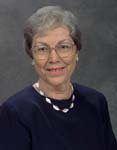2003 William Procter Prize for Scientific Achievement
Achievement
Nuclear chemist Darleane C. Hoffman is an internationally recognized authority on the heaviest elements--those much heavier than uranium and plutonium that typically decay to lighter elements very quickly. She holds joint appointments at Lawrence Berkeley National Laboratory and at the University of California at Berkeley. She was a member of the Berkeley Lab team that confirmed the discovery of element 106, named seaborgium for her long-time colleague, Nobel laureate Glenn Seaborg. Her achievements also include discovery of microscopic quantities of a new chemical element in nature, primordial plutonium-244. In addition, she is noted for her leadership in the discovery in element 100 (fermium) of a new phenomenon called "symmetric spontaneous fission," which results in two "daughter" nuclei of nearly equal mass. She led the application of "one-atom-at-a-time" chemistry to studies of the chemical and nuclear properties of the heaviest elements. Born in Terril, Iowa, Hoffman attended Iowa State University, where she was inducted into Sigma Xi and received a Ph.D. in chemistry in 1951. In 1953, she moved from Oak Ridge National Laboratory to Los Alamos, where she would become the first female leader of a technical division. She also became leader of the Heavy Element and Radiochemistry Group at Lawrence Berkeley Laboratory. From 1991 to 1996, she served as charter director of the Seaborg Institute for Transactinium Science at the Lawrence Livermore National Laboratory. Among her many honors are the 2000 Priestley Medal, the 1983 Nuclear Chemistry Award and the 1990 Francis P. Garvan-John M. Olin Medal, all from the American Chemical Society. Hoffman received the National Medal of Science in 1997.